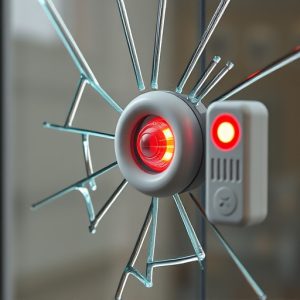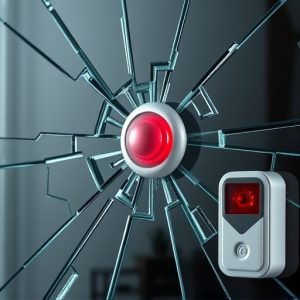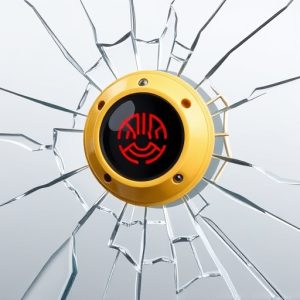Secure Your Space: Mastering Glass Break Alarm Sensor Technology
Glass break alarm sensors are advanced acoustic devices that accurately detect the sound patterns of…….
Glass break alarm sensors are advanced acoustic devices that accurately detect the sound patterns of breaking glass, distinguishing them from other loud noises to minimize false alarms. These sensors are crucial for immediate detection of unauthorized entry into homes and businesses, including critical infrastructure like power plants and data centers. For optimal security, they should be strategically placed near windows and doors, calibrated to the specific acoustic environment of the property, and tested monthly to ensure reliability. Maintenance includes cleaning the sensor and microphone regularly and updating firmware as needed to maintain peak performance. Prompt troubleshooting and professional assistance can address any malfunctions, ensuring that these sensors function effectively as a key component of home security systems.
When it comes to fortifying your home or business against intrusion, a glass break alarm sensor stands as a critical component in your security arsenal. This innovative technology is designed to detect the sound of breaking glass, signaling an immediate response to potential threats. In our comprehensive guide, we delve into the inner workings of these sensors, their diverse applications, and how they can be effectively installed and configured for robust security measures. Additionally, we address maintenance tips and troubleshooting common issues to ensure your system remains reliable and effective. Understanding and utilizing a glass break alarm sensor is not just about safety; it’s about peace of mind.
Understanding Glass Break Alarm Sensors: Detection Mechanisms and Applications
Glass break alarm sensors are sophisticated acoustic devices engineered to detect the sound patterns associated with the breaking of glass. These sensors operate by capturing and analyzing sound waves within their vicinity, distinguishing between normal background noise and the distinct frequency and amplitude patterns produced by broken glass. Upon recognizing these specific sonic signatures, the sensor triggers an alarm system, alerting occupants or security personnel to a potential breach in real-time. The technology behind these sensors has advanced significantly, enabling them to differentiate between the sound of glass breaking and other loud noises, thereby minimizing false alarms.
The applications for glass break alarm sensors are diverse and span across residential, commercial, and industrial security landscapes. In homes, they offer an additional layer of protection by alerting homeowners to unexpected intrusions. In commercial settings, such as retail stores or offices, these sensors act as a deterrent against shoplifting or unauthorized entry during off-hours. On a larger scale, in critical infrastructure like power plants or data centers, glass break alarm sensors contribute to the overall security protocol by detecting and responding to potential threats early on, thus ensuring the protection of valuable assets and maintaining operational continuity. These sensors are integral components of comprehensive security systems, enhancing both physical safety and peace of mind for property owners and operators.
Installing and Configuring Your Glass Break Alarm Sensor for Optimal Security
When securing your property, a glass break alarm sensor serves as an indispensable component in your arsenal of security measures. Upon installation, it’s imperative to position the sensor near windows and doors, as these are common entry points for intruders. Carefully follow the manufacturer’s instructions for placement to ensure optimal coverage and sensitivity. Adhering the sensor components to the frame and the pane of a window or glass door will allow it to detect the specific sound frequencies that shatter glass emits.
After installation, configuration is key. Most glass break alarm sensors come with adjustable sensitivity settings. It’s advisable to set these according to the environment in which they are installed—factors such as nearby construction, traffic, or the acoustics of your home can cause false alarms if not properly calibrated. Additionally, regularly test your system to confirm that it responds accurately to glass breakage and integrates seamlessly with your broader security system. Proper configuration and testing will enhance your system’s effectiveness and provide you with a reliable layer of protection against unauthorized entry.
Maintenance and Troubleshooting Common Issues with Glass Break Alarm Systems
Glass break alarm sensors are a critical component of home security systems, designed to detect the sound of breaking glass and trigger an alarm. Regular maintenance is essential for ensuring their effectiveness. To begin with, it’s advisable to test the sensor monthly by simulating the sound of breaking glass within its range, as specified by the manufacturer. This helps confirm that the sensor is sensitive enough to distinguish between normal sounds and potential intrusion attempts. Additionally, the sensor should be cleaned regularly to remove dust, debris, or any obstructions that may interfere with its performance. In case of malfunction or activation of the sensor without breaking glass, troubleshooting can often resolve the issue. Common troubleshooting steps include checking the sensor’s connections, ensuring it is positioned correctly (free from vibrations and away from heating and cooling sources), and making sure that the microphone is unobstructed. If the sensor continues to operate erratically after these steps, professional assistance should be sought to avoid false alarms or missed detections. It’s also important to keep the sensor’s firmware up to date, as manufacturers may release updates addressing specific issues or improving sensitivity and accuracy. Proactive maintenance and timely troubleshooting are key to maintaining a glass break alarm sensor’s reliability and ensuring it functions as intended when needed.


